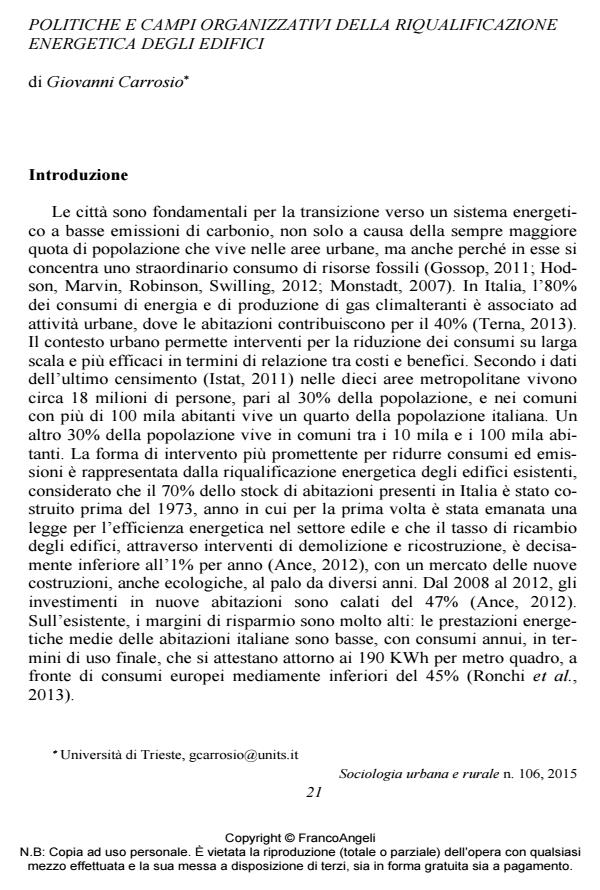Policies and Organizational Fields of Building Energy Retrofit
Journal title SOCIOLOGIA URBANA E RURALE
Author/s Giovanni Carrosio
Publishing Year 2015 Issue 2015/106
Language Italian Pages 24 P. 21-44 File size 315 KB
DOI 10.3280/SUR2015-106002
DOI is like a bar code for intellectual property: to have more infomation
click here
Below, you can see the article first page
If you want to buy this article in PDF format, you can do it, following the instructions to buy download credits

FrancoAngeli is member of Publishers International Linking Association, Inc (PILA), a not-for-profit association which run the CrossRef service enabling links to and from online scholarly content.
The article discusses the general aspects of the energy retrofit of existing buildings, highlighting how the incentive policies and technology paths have produced a vicious circle, which hinders the spread of energy retrofits. The first part focuses on the international literature and identifies some useful dimensions to be applied to the illustration of the state of the art in Italy; the second part analyzes the national policies, the mechanisms that minimize effects and the reasons for the absence of medium to large scale energy retrofit cases in Italian cities; the third part deals with the issue from the point of view of technology paths, highlighting some of the difficult aspects of consolidation of the energy retrofit organizational field and the ongoing uncertainty around the efficiency and savings devices. In the conclusions some indications for policy are provided, highlighting how urban policies invest more on energy efficiency than energy saving, debunking incentive systems adopted on a national scale.
Keywords: Energy Retrofit, Urban Policies, Carbon Lock-In, Organizational Field, Technological Path, Uncertainty.
- Eco-Welfare and the Energy Transition Lorenzo De Vidovich, pp.73 (ISBN:978-3-031-55027-0)
- The ‘patchy’ spread of renewables: A socio-territorial perspective on the energy transition process Giovanni Carrosio, Ivano Scotti, in Energy Policy /2019 pp.684
DOI: 10.1016/j.enpol.2019.02.057 - Energy retrofitting of urban buildings: A socio-spatial analysis of three mid-sized Italian cities Natalia Magnani, Giovanni Carrosio, Giorgio Osti, in Energy Policy 111341/2020 pp.111341
DOI: 10.1016/j.enpol.2020.111341 - District heating and ambivalent energy transition paths in urban and rural contexts Giovanni Carrosio, Natalia Magnani, in Journal of Environmental Policy & Planning /2020 pp.460
DOI: 10.1080/1523908X.2020.1767548 - Understanding the Energy Transition Giovanni Carrosio, pp.53 (ISBN:978-3-030-83480-7)
Giovanni Carrosio, Politiche e campi organizzativi della riqualificazione energetica degli edifici in "SOCIOLOGIA URBANA E RURALE" 106/2015, pp 21-44, DOI: 10.3280/SUR2015-106002